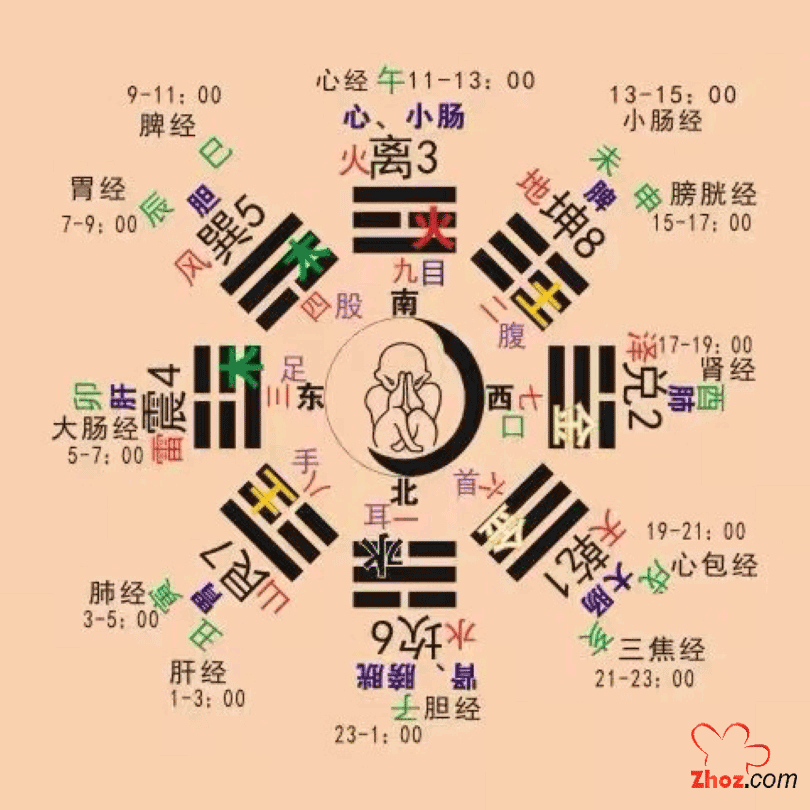中医与五行
“Water moistens downward, fire blazes upward, wood bends and straightens, metal transforms and reforms, and earth is the source of agriculture” is a concise summary of the characteristics of the Five Elements. These characteristics hold significant importance in Traditional Chinese Medicine (TCM) theory and are closely related to aspects such as health preservation, diagnosis, and treatment. Below is an organized overview of the relationship between the Five Elements and TCM:
Characteristics of the Five Elements
1. Characteristics of Wood
“Wood bends and straightens.” Here, “bend” refers to curvature, and “straight” refers to extension. “Bend and straighten” vividly describes the growth form of trees, with the trunk standing upright and branches bending outward. This leads to the understanding that wood embodies characteristics of growth, upward movement, comfort, and unimpeded flow. All things and phenomena with these characteristics can be classified under wood.
2. Characteristics of Fire
“Fire blazes upward” refers to the phenomenon of fire burning, emitting light and heat, scattering warmth, and rising. This implies that fire possesses qualities of warmth, brightness, and ascension. All things and phenomena with these characteristics can be classified under fire.
3. Characteristics of Earth
“Earth is the source of agriculture,” where “source” means to provide; “agriculture” refers to planting crops and harvesting them. The land provides the foundation for human beings to engage in planting and harvesting grains, thus embodying characteristics of creation, support, and acceptance. All things and phenomena with these characteristics can be classified under earth.
4. Characteristics of Metal
“Metal transforms and reforms” encompasses both the meanings of compliance and change. The “transform and reform” characteristic of metal arises from the understanding that metallic substances can be shaped and altered for human use. This leads to the conclusion that metal embodies qualities of transformation, restraint, reduction, and purification. All things and phenomena with these characteristics can be classified under metal.
5. Characteristics of Water
“Water moistens downward” indicates that water has properties of moisture, coolness, gentleness, and downward flow. This leads to the understanding that water embodies qualities of coolness, moisture, downward movement, and storage. All things and phenomena with these characteristics can be classified under water.
Integration of the Five Elements with TCM Basic Theory
1. Correspondence between the Five Organs and the Five Elements
In TCM, the five organs of the human body (liver, heart, spleen, lung, kidney) correspond to the Five Elements: liver corresponds to wood, heart to fire, spleen to earth, lung to metal, and kidney to water. This correspondence not only reflects the application of the Five Elements theory in TCM but also reveals the interrelationships and physiological functions among the organs.
2. Interactions of the Five Elements
There exists a relationship of mutual generation and restriction among the Five Elements, which is used in TCM to explain the physiological connections and pathological changes among the organs. For example, wood generates fire, indicating that the liver nourishes the heart, while water restrains fire, indicating that the kidney controls the heart to prevent excessive heart fire.
Applications of the Five Elements in TCM Health Preservation
1. Dietary Regulation
TCM health preservation emphasizes the Five Elements properties of food, suggesting that individuals choose foods based on their constitution and seasonal changes. For example, in spring (wood), it is advisable to consume green vegetables to nourish the liver; in summer (fire), light foods to nourish the heart; in autumn (metal), foods that moisten the lungs to prevent dryness; and in winter (water), warming foods to nourish the kidneys.
2. Exercise Regulation
Exercise in TCM health preservation also follows the principles of the Five Elements, using different forms of exercise to harmonize the organs. For instance, Tai Chi and yoga emphasize the unity of body and mind, helping to regulate the functions of the organs.
3. Mental Regulation
TCM places great importance on emotional health, believing that emotions are closely related to the organs. According to the Five Elements theory, excessive emotions can damage the corresponding organs. Therefore, TCM recommends regulating emotions to maintain balance among the organs.
Applications of the Five Elements in TCM Diagnosis
In TCM diagnosis, the Five Elements theory is often used to analyze illness and determine its causes. By observing the patient’s symptoms, signs, and pulse, TCM practitioners can assess the nature of the pathogenic factors and the condition of the organs, thereby formulating appropriate treatment plans.
Applications of the Five Elements in TCM Treatment
1. Herbal Medicine
The properties and pathways of traditional Chinese herbs are closely related to the Five Elements theory. TCM practitioners select herbs based on their properties and pathways to achieve the goal of harmonizing the organs and treating diseases.
2. Acupuncture Treatment
Acupuncture therapy also follows the principles of the Five Elements, stimulating specific acupuncture points to regulate the functions of the organs. The selection of acupuncture points and the techniques used in needling reflect the ideas of the Five Elements theory.
In summary, the Five Elements theory is not only a foundational aspect of TCM but also an important framework for understanding and practicing health preservation, diagnosis, and treatment in TCM. Through a deep understanding of the characteristics of the Five Elements, TCM can more effectively maintain and promote health.
“水曰润下,火曰炎上,木曰曲直,金曰从革,土爰稼穑”是对五行特性的高度概括,这些特性在中医理论中占据重要地位,与中医的养生、诊断和治疗等方面有着密切的联系。以下是对五行与中医关系的整理概述:
五行特性
木的特性
“木曰曲直”,其中“曲”指屈曲,“直”指伸展。“曲直”生动地描述了树木的生长形态,主干挺直向上,树枝曲折向外。这引申为木具有生长、升发、舒畅、条达等特征,凡具有此类特性的事物均可归属于木。
火的特性
“火曰炎上”,指火在燃烧时发光放热、光热四散、蒸腾上升的象征,引申为火有温热、光明、升腾等特性,凡具有此类特性的事物均可归属于火。
土的特性
“土爰稼穑”,其中“爰”意为通达;“稼”指植物播种,“穑”指庄稼收获。土地为人类提供种植和收获谷物的基础,因此土具有生化、承载、受纳等特征,凡具有此类特性的事物均可归属于土。
金的特性
“金曰从革”,含有顺从和变革两个方面的意义。金的“从革”特性源于金属物质顺从人意、改变外形、制成器物的认识,引申为金有变革、肃杀、敛降、洁净等特性,凡具有此类特性的事物均可归属于金。
水的特性
“水曰润下”,指水具有滋润寒凉、性质柔顺、流动趋下的特性,进而引申为水有寒凉、滋润、向下、闭藏等特性,凡具有此类特性的事物均可归属于水。
五行与中医基础理论的融合
1. 五脏对应五行
中医将人体的五脏(肝、心、脾、肺、肾)与五行相对应:肝属木、心属火、脾属土、肺属金、肾属水。这种对应关系不仅体现了五行学说在中医中的应用,也揭示了五脏之间的相互关系和生理功能。
2. 五行的生克制化
五行之间存在相生相克的关系,这种关系在中医中用于解释五脏之间的生理联系和病理变化。例如,木生火表示肝对心的滋养作用,水克火则表示肾对心的制约作用,以防止心火过旺。
五行在中医养生中的应用
1. 饮食调养
中医养生强调饮食的五行属性,建议根据个人的体质和季节变化选择食物。例如,春季属木,宜食绿色蔬菜以养肝;夏季属火,宜食清淡食物以养心;秋季属金,宜食润肺食物以防秋燥;冬季属水,宜食温补食物以养肾。
2. 运动调理
中医养生中的运动也遵循五行原则,通过不同的运动方式调和五脏。例如,太极拳、瑜伽等运动强调身心的和谐统一,有助于调节五脏的功能。
3. 精神调养
中医注重情志养生,认为情志与五脏密切相关。根据五行学说,情志过极会损伤相应的脏腑。因此,中医建议通过调节情志来保持五脏的平衡。
五行在中医诊断中的应用
中医诊断中常运用五行学说来分析病情和判断病因。通过观察患者的症状、体征和脉象等,中医医师可以判断病邪的性质和脏腑的受损情况,进而制定相应的治疗方案。
五行在中医治疗中的应用
1. 药物治疗
中药的性味归经与五行学说密切相关。中医根据药物的性味归经选择药物,以达到调和五脏、治疗疾病的目的。
2. 针灸治疗
针灸疗法也遵循五行原则,通过刺激特定的穴位来调节五脏的功能。针灸穴位的选择和针刺手法的运用都体现了五行学说的思想。
综上所述,五行学说不仅是中医理论的基础,也是理解和实践中医养生、诊断和治疗的重要框架。通过对五行特性的深入理解,中医能够更有效地维护和促进健康。
